In today's fast-paced and technology-driven world, it is becoming increasingly common to see people constantly engaged with their ear devices. These gadgets, often deemed indispensable companions, have seamlessly integrated into our daily routines. However, behind the convenience and entertainment they bring, lie a variety of potential implications that are worth exploring.
Sustained use of ear devices, such as headphones and earbuds, can elicit a cascade of effects on our physical and mental well-being. The alluring allure of immersing oneself in melodious tunes or engaging podcasts may seem harmless, but it is crucial to acknowledge the underlying risks associated with excessive utilization. It is essential to recognize that these devices exert significant influence on our auditory senses, psychological state, and even overall productivity.
When we subject our ears to continuous and prolonged exposure to sound waves, it can result in an assortment of audiological complications. The repetitive strain imposed on the delicate structures of the ear may lead to hearing loss, tinnitus, and heightened sensitivity to loud noises. Moreover, the prolonged usage of ear devices can often result in the habituation of louder volume levels, gradually desensitizing our ears to quieter sounds and further exacerbating the risks of damage.
Beyond the physical consequences, the persistent use of ear devices can have psychological ramifications as well. Constantly immersing ourselves in a world of entertainment, isolated from our surroundings, can hinder interpersonal communication and social connections. By frequently escaping into our personal sound bubbles, we may inadvertently alienate ourselves from the outside world, missing out on significant interactions and experiences that enrich our lives.
The Impact of Prolonged Use of Headphones on Hearing
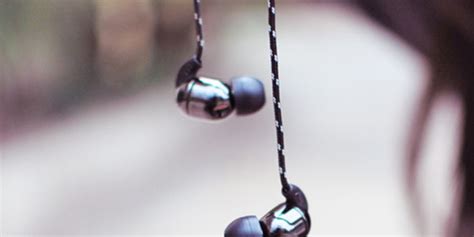
Excessive and continuous utilization of headphones can have profound effects on one's sense of hearing. The sustained exposure to loud sounds transmitted directly into the ears can lead to various auditory complications, jeopardizing the overall health and function of the auditory system. This section delves into the repercussions of prolonged headphone use on hearing abilities, emphasizing the importance of responsible listening habits.
Extended periods of headphone usage at high volume levels can contribute to the gradual degradation of auditory acuity. The delicate structures within the ear, including the hair cells responsible for processing sound waves, can become damaged or even destroyed due to the continuous exposure to loud noises. This impairment can result in decreased sensitivity to certain frequencies, making it difficult to discern subtle sounds and disrupting the natural process of hearing.
Moreover, repeated exposure to amplified sounds through headphones can trigger a phenomenon known as temporary threshold shift (TTS). TTS occurs when the auditory system becomes temporarily desensitized to sound due to a period of prolonged exposure to high-intensity noise. This effect may cause individuals to perceive sounds as muffled or less distinct, leading to difficulties in communicating and experiencing the full auditory spectrum.
It is essential to acknowledge that the effects of prolonged headphone use on hearing are not limited to immediate consequences. Over time, consistent exposure to loud volumes can contribute to permanent hearing loss, a condition characterized by irreversible damage to the auditory system. Permanent hearing loss can significantly impact one's quality of life, leading to communication difficulties, emotional distress, and diminished overall well-being.
Protecting one's hearing health requires awareness and proactive measures. It is crucial to regulate the volume and duration of headphone use, opting for lower volume levels and occasional breaks to allow the auditory system to recover. Additionally, considering the use of noise-canceling headphones or over-ear headphones that do not directly transmit sound into the ear canal can help minimize the risk of hearing damage.
In conclusion, the impact of prolonged headphone use on hearing can be detrimental, encompassing temporary threshold shifts, decreased auditory acuity, and even permanent hearing loss. Adhering to responsible listening practices, such as moderating volume levels and taking breaks, can mitigate these risks, preserving the integrity of the auditory system and promoting long-term hearing health.
The Evolution of Personal Audio Devices and Their Ubiquitous Adoption
In this section, we explore the historical journey of personal audio devices and the widespread integration of headphones into our daily lives. From their inception to the present day, headphones have undergone remarkable advancements, revolutionizing the way we consume audio content.
Over time, headphones have transformed from bulky and cumbersome devices to sleek and portable accessories that enable us to enjoy music, podcasts, and other forms of audio entertainment anytime and anywhere. This transition has been driven by the constant pursuit of enhancing user experience, ergonomics, and audio quality.
Initially, headphones were primarily used for professional purposes, such as in the field of telephony, radio broadcasting, and aviation. As technology progressed and music became more accessible to the masses, headphones started to make their way into everyday consumer electronics.
The advent of portable music players, such as Walkmans and iPods, in the late 20th century further catapulted the popularity of headphones. These devices allowed people to carry their music collections in their pockets, with headphones acting as the gateway to an immersive sonic experience in a highly personalized manner.
In recent years, the widespread adoption of smartphones and streaming services has intensified the integration of headphones into our daily routines. With a simple plug or wireless connection, headphones have become a ubiquitous accessory for individuals of all ages and backgrounds, accompanying them through various activities, be it commuting, exercising, studying, or simply unwinding.
The evolution of headphones has not only enriched our audio experiences but has also raised concerns about the potential consequences of constant usage, which will be explored in subsequent sections. Understanding the background and widespread usage of headphones is crucial to comprehending the impact they can have on our well-being.
The Science Behind Hearing Damage and the Impact of Regular Headphone Usage
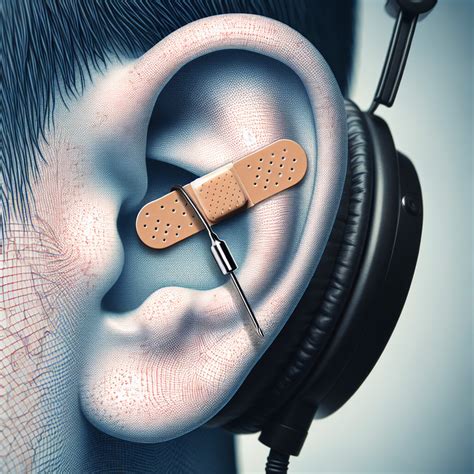
Understanding the connection between continuous use of headphones and potential hearing loss is crucial in today's era of constant audio consumption. This section delves into the scientific explanations of how prolonged headphone use can lead to negative consequences for our auditory system.
The intricate mechanisms of the human ear:
The ear is an intricate organ responsible for capturing and transmitting sound waves to the brain, allowing us to perceive the world around us. It comprises several delicate components, including the outer, middle, and inner ear, each playing a vital role in the process of hearing.
The role of sound waves:
When we listen to audio through headphones, sound waves are converted into electrical signals that are then delivered directly to our ears. These signals are amplified, ensuring that we can hear our desired audio with clarity and intensity.
The potential dangers of excessive sound exposure:
However, prolonged exposure to high volume levels and extended periods of headphone use can put excessive strain on our auditory system. The delicate structures within our ears can become damaged, leading to various degrees of hearing loss.
The impact of loud music and noise levels:
High volume levels, particularly in headphones, can cause direct mechanical damage to the sensitive hair cells in the cochlea of the inner ear. These hair cells are responsible for converting sound vibrations into electrical signals for our brain to interpret. Over time, prolonged exposure to loud music can lead to irreversible damage and permanent hearing loss.
The importance of practicing safe listening habits:
It is crucial for individuals to be aware of the potential consequences of regular headphone use and take steps to protect their hearing. This includes using headphones at a moderate volume, taking regular breaks, and incorporating noise-cancelling technology to reduce exposure to outside noises.
In conclusion, a solid understanding of the science behind hearing damage caused by headphone use enables us to make informed decisions about our audio consumption habits. By being aware of the dangers associated with excessive headphone use and adopting safe listening practices, we can protect and preserve our hearing for years to come.
Physical Impact of Excessive Headphone Usage
When individuals excessively rely on headphones for audio consumption, they may unknowingly subject themselves to various physical consequences. Overuse of headphones can result in a range of detrimental effects on the body, stemming from extended periods of exposure to high volumes and close proximity to the ears. These repercussions, which are often underestimated, warrant attention and awareness.
Hearing Loss: Prolonged exposure to loud music through headphones can lead to permanent hearing damage. The sensitive structures within the inner ear can become damaged over time, causing gradual hearing loss. It is crucial to recognize the importance of setting volume levels at a safe and comfortable level to safeguard against this irreversible impairment.
Tinnitus: Another potential outcome of excessive headphone usage is the development of tinnitus, a condition characterized by a ringing sensation in the ears. This persistent noise can be disruptive, making it difficult to concentrate or enjoy quiet environments. Prevention lies in using headphones sparingly and at moderate volume levels.
Ear Infections: Wearing headphones for extended periods can create a warm and moist environment within the ear canal, making it a breeding ground for bacteria and fungi. This can lead to painful ear infections, such as swimmer's ear. Maintaining proper hygiene, such as cleaning headphones regularly and avoiding sharing them, can help reduce the risk of infections.
Head and Neck Discomfort: Constant headphone use often involves prolonged periods of wearing them, which can result in discomfort and strain in the head and neck region. Pressure exerted by headphones can cause headaches, neck stiffness, and even postural imbalances. Taking breaks, stretching, and using headphones with adjustable and well-padded headbands can mitigate these physical discomforts.
Being aware of the physical consequences of excessive headphone use is key to maintaining our auditory health and overall well-being. By adopting appropriate listening practices and taking necessary precautions, we can minimize the potential risks associated with prolonged headphone usage.
The Impact of Prolonged Earphone Usage on Hearing
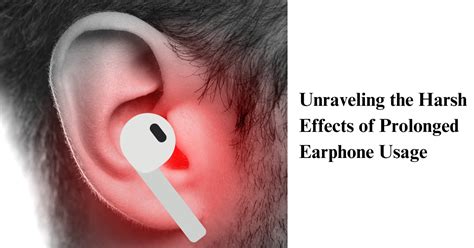
Extended and continuous utilization of earphones can significantly affect the auditory system, particularly the ears. This article will explore how prolonged earphone use can have adverse effects on hearing health.
One consequence of excessive earphone usage is the potential for hearing loss. Consistently listening to high volume levels over extended periods can damage the delicate structures of the ear, such as the hair cells in the inner ear responsible for transmitting sound signals to the brain. The continuous exposure to loud sounds can cause these hair cells to become damaged or even die, leading to permanent hearing loss. It is crucial to note that hearing loss can occur gradually and often goes unnoticed until it becomes significant.
Another effect of prolonged headphone use is the development of tinnitus, a condition characterized by a constant ringing or buzzing sensation in the ears. When exposed to loud sounds for an extended period, the auditory system can become overstimulated, resulting in the perception of phantom sounds even in the absence of external noise. Tinnitus can be highly bothersome and interfere with daily activities, affecting overall quality of life.
| Effects of Prolonged Earphone Use | Solutions and Precautions |
|---|---|
| Increased risk of hearing loss | Limit daily earphone usage and keep volume levels at a safe range |
| Tinnitus | Take regular breaks from using earphones and use noise-cancelling headphones instead |
| Ear infections | Keep earphones clean, avoid sharing with others, and maintain good ear hygiene |
| Temporary or permanent ear discomfort | Ensure the earphone fit is comfortable and avoid extended periods of continuous use |
In addition to hearing loss and tinnitus, prolonged earphone use can also contribute to an increased risk of ear infections. The long-term use of earphones can create a warm and moist environment in the ear, which is an ideal breeding ground for bacteria. This can lead to various ear infections, such as otitis externa or swimmer's ear. It is important to maintain proper hygiene, keep earphones clean, and avoid sharing them with others to minimize the risk of infections.
Lastly, using earphones for extended periods can cause temporary or even permanent discomfort in the ears. The pressure exerted by tightly fitting earphones can irritate the skin, leading to soreness or pain. It is advisable to choose earphones that provide a comfortable fit and take regular breaks from using them to allow the ears to rest and recover.
Overall, prolonged usage of earphones can have detrimental effects on the ears, including hearing loss, tinnitus, ear infections, and discomfort. It is essential to be mindful of the volume levels, take regular breaks, maintain good ear hygiene, and use proper-fitting earphones to minimize the risks associated with prolonged earphone use.
Effects of Prolonged Headphone Usage: Impact on Posture and Neck Strain
Extended and frequent use of headphones can lead to a variety of consequences beyond just hearing impairment. One significant aspect to consider is the potential impact on posture and the development of neck strain.
When individuals wear headphones for prolonged periods, they often adopt unnatural positions to accommodate the device. Whether it involves tilting the head forward, hunching the shoulders, or leaning toward the audio source, these actions frequently result in poor posture and increased strain on the neck muscles. The neck, being a crucial component of the body's skeletal system, is easily affected by the prolonged stress commonly associated with continuous headphone usage.
It is essential to recognize that the strain placed on the neck may not be immediately obvious, as it can develop gradually over time. However, individuals who regularly use headphones may begin to experience discomfort, stiffness, and even pain in their neck and upper back areas. These symptoms can intensify if left unaddressed, potentially leading to chronic conditions such as tension headaches or cervical spine issues. The strain from headphone usage can also exacerbate existing neck or back problems, making it crucial to prioritize proper posture and heed the warning signs.
To mitigate the risk of postural issues and neck strain caused by headphone use, it is advisable to take breaks and alternate between headphone usage and speaker listening whenever feasible. Additionally, practicing good posture while using headphones, such as sitting up straight with the shoulders relaxed and the head aligned with the spine, can help reduce the strain on the neck muscles. Exercises targeting the neck and upper back, as well as regular stretching breaks, can also aid in alleviating tension and maintaining long-term musculoskeletal health.
Mental and Psychological Effects of Prolonged Use of Headphones
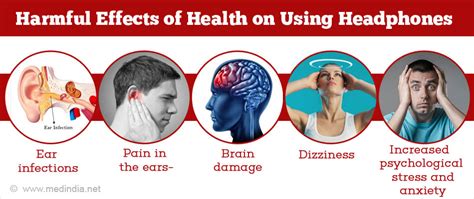
Extended and continuous use of headphones can have various mental and psychological consequences on individuals. The harmful impacts of excessive headphone use are not limited to physical health, but they also extend to the mind and emotions, affecting mental well-being and psychological functioning.
1. Isolation and alienation from the surroundings: When headphones are constantly used for prolonged periods, individuals may become engrossed in their own sonic world, isolating themselves from the real-world environment. This prolonged isolation can lead to feelings of detachment, loneliness, and disconnection from the social interactions and events happening around them.
2. Increased risk of auditory overstimulation: Continuous exposure to loud music or sound through headphones can potentially lead to auditory overstimulation. This overstimulation can result in an increased risk of experiencing symptoms such as tinnitus, hyperacusis, and temporary or permanent hearing loss. The constant bombardment of high-volume sounds through headphones can disrupt the delicate balance of the auditory system, affecting overall mental well-being.
3. Impaired concentration and attention: Engaging in prolonged headphone use, especially with distracting or loud audio content, can significantly impair an individual's ability to concentrate and pay attention to important tasks and responsibilities. This can impact productivity levels and increase the likelihood of making mistakes in various areas of life, such as work or academics.
4. Escapism and dependency on headphones: The consistent use of headphones can serve as an escape mechanism from reality or stressful situations. This tendency to rely on headphones as a coping mechanism may result in a dependency on the device, leading to difficulties in dealing with emotional challenges or facing real-life situations without the aid of headphones.
5. Negative impact on mood and emotional well-being: Prolonged headphone use can have adverse effects on an individual's mood and emotional well-being. Listening to certain genres of music or engaging in emotionally intense audio content for extended periods can influence emotions, leading to heightened anxiety, sadness, or irritability. Additionally, the isolation that comes with headphone usage can contribute to feelings of social anxiety and emotional disconnection.
- In summary, prolonged headphone use can lead to:
- - Isolation and alienation
- - Auditory overstimulation
- - Impaired concentration and attention
- - Escapism and dependency
- - Negative impact on mood and emotional well-being
It is vital to be mindful of the potential mental and psychological effects of excessive headphone use and incorporate healthy listening habits into our daily lives.
Social Isolation: How Headphones Impact Interactions
One of the repercussions of frequent headphone use is the potential for social isolation, as these devices can significantly impact human interactions.
When individuals rely heavily on headphones, it limits their ability to engage with the world around them. Rather than actively participating in conversations or connecting with others, they may choose to retreat into their own personal auditory experience. This withdrawal from social interactions can lead to feelings of isolation and detachment from the people and events happening in their immediate surroundings.
In addition, wearing headphones on a regular basis can be seen as a signal to others that the wearer is not interested in engaging in conversation or forming connections. The physical presence of headphones can create a barrier between individuals and may discourage others from initiating interactions, further exacerbating social isolation.
Furthermore, the constant use of headphones can disrupt natural social cues and non-verbal communication. People rely on facial expressions, body language, and other subtle cues to navigate social interactions effectively. When these cues are hidden or diminished by the presence of headphones, it becomes more difficult for individuals to interpret and respond appropriately, leading to potential misunderstandings or missed opportunities for meaningful connection.
Moreover, the use of headphones in social settings can contribute to a general decline in social skills. By choosing to immerse oneself in personal audio experiences rather than actively participating in conversations and group activities, individuals may miss out on valuable opportunities to practice and develop essential social skills such as active listening, empathy, and effective communication.
In conclusion, the constant use of headphones can have negative consequences on social interactions, leading to a potential sense of isolation, missed connections, and reduced social skills. It is important for individuals to strike a balance between personal audio experiences and engaging with the world around them to maintain healthy and meaningful social connections.
The Link Between Headphone Usage and Tinnitus
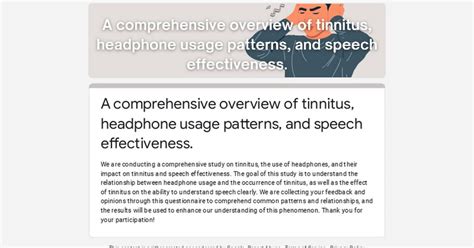
Excessive and prolonged utilization of headphones may lead to the development of a condition called tinnitus. This connection between the use of headphones and tinnitus has been observed in various studies and has raised concerns among healthcare professionals.
Tinnitus refers to the perception of sound in the absence of an external source. It can manifest as a ringing, buzzing, or whistling sound in the ears, and it can be temporary or chronic. Although tinnitus can have various causes, the improper use of headphones is recognized as one potential factor that can contribute to its onset.
When headphones are worn at high volume levels for extended periods, the delicate structures of the inner ear can become damaged. These structures, including the hair cells in the cochlea, are responsible for transmitting sound signals to the brain. However, excessive noise exposure can result in their impairment or loss.
The prevalence of tinnitus among frequent headphone users is a concerning issue that demands attention. A study conducted on a group of individuals who regularly used headphones revealed a higher incidence of tinnitus compared to those who did not use headphones or used them sparingly. Moreover, the severity of tinnitus symptoms was found to be directly related to the duration and volume of headphone use.
To prevent the development of tinnitus, it is recommended to follow safe listening practices when using headphones. This includes limiting the duration and volume levels, taking regular breaks, and using noise-canceling or over-ear headphones when possible. Awareness about the potential risks associated with excessive headphone use can help individuals protect their hearing and minimize the likelihood of experiencing tinnitus.
In conclusion, there is a strong association between headphone use and the development of tinnitus. Understanding the connection and adopting preventive measures can play a crucial role in preserving auditory health and reducing the prevalence of this distressing condition.
The Potential Link between Headphones and Cognitive Decline
One area of concern regarding the widespread use of headphones is the potential link between their usage and cognitive decline. While many enjoy the convenience and immersive experience provided by headphones, there is increasing evidence to suggest that prolonged and excessive use may have detrimental effects on cognitive function.
Research has indicated that prolonged exposure to loud music or noise through headphones can lead to damage to the auditory system, including the delicate hair cells in the inner ear. This damage can result in hearing loss or tinnitus, which are known risk factors for cognitive decline. Additionally, the constant stimulation of the auditory system by headphone use may disrupt normal brain functioning and lead to decreased attention span, impaired memory, and reduced cognitive abilities.
Furthermore, the use of headphones often involves isolating oneself from the surrounding environment, creating a cocoon-like experience. While this may enhance the enjoyment of music or audio content, it can also limit social interaction and deprive individuals of important sensory input. Social engagement and exposure to new stimuli are crucial for maintaining cognitive health and preventing cognitive decline.
| Potential Consequences | Explanation |
|---|---|
| Hearing loss | Prolonged exposure to loud music or noise through headphones can damage the auditory system, leading to hearing loss. |
| Tinnitus | Excessive use of headphones can result in a ringing or buzzing sensation in the ears known as tinnitus. |
| Decreased attention span | The constant stimulation of the auditory system by headphone use can disrupt normal brain functioning, leading to a reduced attention span. |
| Impaired memory | Prolonged and excessive use of headphones may impair memory and cognitive abilities over time. |
| Social isolation | Isolating oneself with headphones can limit social interaction and deprive individuals of important sensory input, which is crucial for maintaining cognitive health. |
While further research is needed to fully understand the potential link between headphones and cognitive decline, it is important to be mindful of our headphone usage and take breaks to allow our auditory system and brain to rest. Maintaining a balance between headphone use and natural sensory experiences can help mitigate the potential negative consequences on cognitive function.
[MOVIES] [/MOVIES] [/MOVIES_ENABLED]FAQ
What are the consequences of constant headphone use?
Constant headphone use can lead to various consequences such as hearing loss, tinnitus (ringing in the ears), ear infections, and increased risk of accidents due to reduced awareness of the surroundings.
Can wearing headphones for long periods of time cause hearing loss?
Yes, wearing headphones for long periods of time and at high volume levels can lead to hearing loss. The loud sounds produced directly into the ear can damage the delicate structures of the inner ear, leading to permanent hearing damage.
Is it true that constant headphone use can cause ear infections?
Yes, constant headphone use can increase the risk of ear infections. When wearing headphones, the ears can become warm and moist, creating a favorable environment for the growth of bacteria. Additionally, prolonged use may prevent proper air circulation in the ear canal, further increasing the likelihood of infection.




